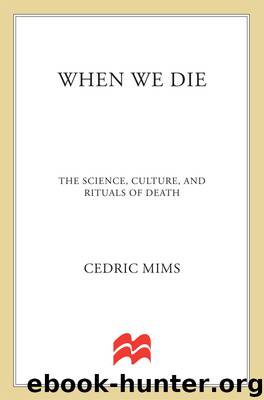When We Die by Cedric Mims

Author:Cedric Mims
Language: eng
Format: epub
ISBN: 9781466883857
Publisher: St. Martin's Press
8
Unusual Methods of Disposal
Not everyone is burnt, buried or exposed. There are one or two additional ways of disposing of corpses, easier for the soft parts than for the bones. Bones tend to be left over and may be treated or used in different ways, as described in chapters 12 and 14.
Cannibalism
Cannibalism has occurred sporadically in most parts of the world, from prehistoric times up to the present. During the famine of 695–700 in England and Ireland, men ate each other just to survive. Cannibalism was commoner in parts of New Guinea, Australia, North and South America, and Polynesia. Accounts suggesting the regular practice of cannibalism come from tenth-century China, nineteenth-century Africa, and Sumatra before its colonization by the Dutch. In some of these places human flesh was reputed to be for sale in the marketplace.
Why Do People Eat One Another?
Cannibalism can arise from the wish to acquire the qualities of the thing that is eaten, for example by eating a valiant foe slain in battle. Another motive is to pay ritualistic respect to a dead relative. There is a curious logic to the idea that the most fitting burial place for the deceased is inside the body of their living relatives.
In one interesting instance ritualistic cannibalism led to unforeseen results. The Fore people in the highlands of Papua New Guinea used to eat their relatives when they died. Unfortunately a virus-like infectious agent had been present in the brain of an early ancestor and was transmitted through the population by cannibalism. Those who ate the brain (usually women) became infected, and between four and twenty years later developed a severe and in the end fatal neurological disease called kuru. The disease, spread by cannibalism, affected many of the Fore people: and altogether there were 3,700 cases. At one time as many as half the women in villages were ill with kuru. Cannibalism ceased in 1957 and no one born since then has developed the disease. The infectious agent that caused kuru is almost identical with the one that causes scrapie in sheep, BSE in cows and CJD in humans.
Cannibalism as a Way of Life
According to anthropologists, some cannibals eat human flesh simply because it is the best type of food: ‘Man’s flesh is best of all, and afterwards follows monkeys flesh.’ This has been referred to as ‘gourmet cannibalism’. In Melanesian pidgin language the word ‘long-pig’ refers to human flesh as an acceptable item of food.
In 1910 the anthropologist A. P. Rice described the cannibal feast of a Fijian chieftain. The men eaten had been captured in local raids.
And such a feast! It consisted of 200 human bodies, 200 hogs, and 200 baskets of yams. The preparation of the human bodies and of the hogs was identical, and every member of the tribe had of course to partake of the two main dishes – he was not allowed to select one or the other. This was to ensure that the men did not glut themselves on the human bodies
Download
This site does not store any files on its server. We only index and link to content provided by other sites. Please contact the content providers to delete copyright contents if any and email us, we'll remove relevant links or contents immediately.
Periodization Training for Sports by Tudor Bompa(8171)
Why We Sleep: Unlocking the Power of Sleep and Dreams by Matthew Walker(6618)
Paper Towns by Green John(5092)
The Immortal Life of Henrietta Lacks by Rebecca Skloot(4526)
The Sports Rules Book by Human Kinetics(4296)
Dynamic Alignment Through Imagery by Eric Franklin(4118)
ACSM's Complete Guide to Fitness & Health by ACSM(3989)
Kaplan MCAT Organic Chemistry Review: Created for MCAT 2015 (Kaplan Test Prep) by Kaplan(3940)
Introduction to Kinesiology by Shirl J. Hoffman(3726)
Livewired by David Eagleman(3685)
The Death of the Heart by Elizabeth Bowen(3553)
The River of Consciousness by Oliver Sacks(3542)
Alchemy and Alchemists by C. J. S. Thompson(3451)
Bad Pharma by Ben Goldacre(3357)
Descartes' Error by Antonio Damasio(3230)
The Emperor of All Maladies: A Biography of Cancer by Siddhartha Mukherjee(3068)
The Gene: An Intimate History by Siddhartha Mukherjee(3048)
The Fate of Rome: Climate, Disease, and the End of an Empire (The Princeton History of the Ancient World) by Kyle Harper(3003)
Kaplan MCAT Behavioral Sciences Review: Created for MCAT 2015 (Kaplan Test Prep) by Kaplan(2941)
